Description
Description
Many Vibrio parahemolyticus isolated as a cause of food poisoning, produce toxin called hemolysin, and this is the main cause of illness. The hemolysin of V. parahemolyticus mainly interacts with an intestinal tract or the heart, produces diarrhea by enterotoxicity, and also there are severe cases of making a patient die by cardiotoxicity. Two kinds, heat-resistant hemolysin (TDH, thermostable direct hemolysin) and heat-resistant toxin related hemolysin (TRH, TDH-related hemolysin), are known as hemolysins of V. parahemolyticus. Among these, TDH is known for many years and has been studied more extensively. In order to distinguish whether it is the V. parahemolyticus that produces TDH, samples are grown on the Agatsuma medium (blood agar which is added with mannitol), and judged by whether a hemolysis is observed or not. This hemolysis was one of the examining methods, which is called Kanagawa phenomenon to judges whether it is pathogenic V. parahemolytica. However, it became clear that the food poisoning by the V. parahemolyticus of Kanagawa-phenomenon negativity was discovered, and this organism did not produce TDH, but it produced TRH. Moreover, since the Kanagawa phenomenon sensitivity is not so high, the immunological technique employing antibody against toxin is used together for the judgment of pathogenicity of V. parahemolyticus.
TRH is the heat labile toxin protein of molecular weight 21.1 kDa (189 aa). Homology of TDH (21.3 kDa, 189 aa) with TRH is about 60% (reference 1 and 2), and shows partial antigenic similarities. Susceptibility of the blood cells of various animals to TRH differs greatly, and TRH shows more than 100 times in rabbit skin capillary permeability activity than TDH.
This product is an IgG fraction purified from the rabbit anti-TRH serum by salting out and ion-exchange chromatography.
Applications
1) Western blot (2,000~10,000 time dilution) (Fig. 1)
2) Immunoprecipitation(assay dependent) (Fig. 2)
3) ELISA (assay dependent)
Specification
Immunogen: TRH toxoid and toxin purified from culture medium of V. parahemolyticus TRH strain.
Reactivity: TRH toxin and TDH toxin of V.-parahemolyticus (Fig. 3)
Form: 1 mg/ml in PBS, 50% glycerol. Filter-sterilized. Azide- and carrier-free.
Store: Ship at 4°C. Upon arrival centrifuge and store at -20°C.
Data Link
GenBank BAB13778.1 TDH-related hemolysin [Vibrio parahaemolyticus]
UniProKB P19249 Thermostable direct hemolysin 1
References
Honda T. Et al . (1988) Purification and characterization of a hemolysin produced by a clinical isolate of Kanagawa phenomenon-negative Vibrio parahaemolyticus and related to the thermostable direct hemolysin. Infect. Immun. 56 :961-965. . PubMed ID 3126151 Free access
Nishibuchi M et al. ( 1989) Cloning and nucleotide sequence of the gene ( trh) encoding the hemolysin related to the thermostable direct hemolysin of Vibrio parahaemolyticus . Infect Immun 57:2691-7. PubMed ID 2759706 Free access
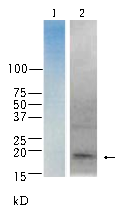
Fig. 1. Detection of TRH toxin in the culture medium of V. parahaemolyticus (TRH) by western blot with anti-TRH antibody. (1) Ten-times condensed sample were analyzed by SDS-PAGE and stained with CBB. (2) The same sample was analyzed by western blot. The antibody at 1/2,000 dilution was used. TRH toxin band is indicated by an arrow.
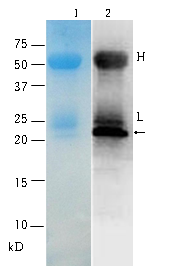
Fig. 2. Immunoprecipitation of TRH toxin from Vibrio parahaemolyticus (TRH) culture medium with anti-TRH antibody. (1) TRH was precipitated with anti-TRH antibody from the same sample as in Fig.1, analyzed by SDS-PAGE and stained with CBB. (2) TRH was precipitated with anti-TRH antibody from the same sample and TRH was detected by WB with anti-TRH antibody. Arrow indicates TRH band. H and L indicate heavy and light chain of IgG, respectively.
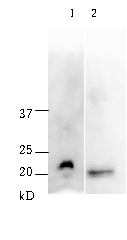
Fig.3. Anti-TRH antibody cross-reacts with TDH toxin in western blot. (1) Partially purified TDH toxin (2) Condensed culture medium of V. haemolyticus. Antibody was used at 1/2,000 dilution for WB.

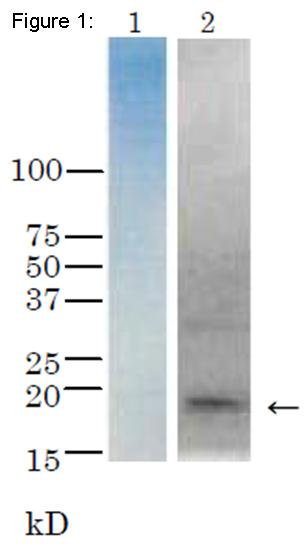
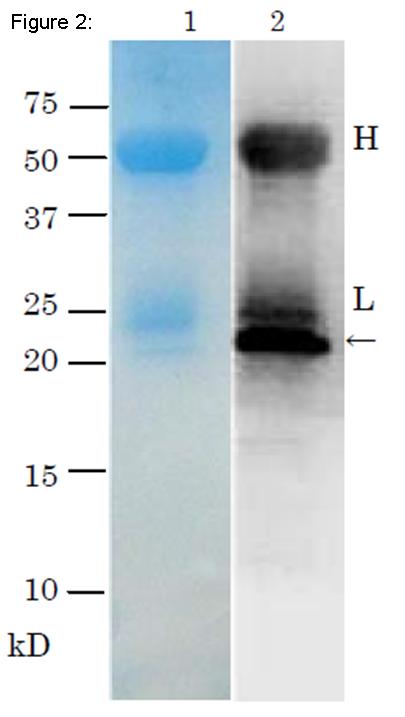
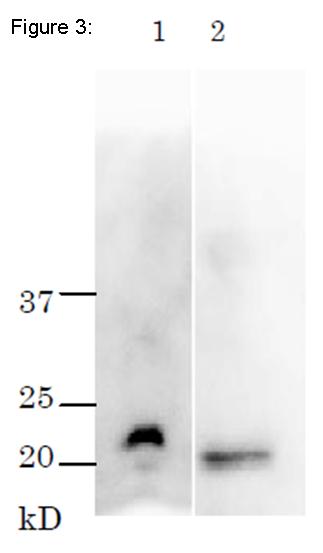

Reviews
There are no reviews yet.